June 1
| 1909 | An OPR exhibit, including its first use of dioramas, at the Alaska-Yukon-Pacific Exposition in Seattle, WA, proves especially popular. When the exposition ends on October 16, the exhibit is shipped to Nebraska for the Corn Show and Omaha Exposition, then to the District of Columbia for the Builders' Exchange Exhibit Company, and later to Knoxville, KY, for the Appalachian Exposition. The exhibit is duplicated and exhibited in over 100 places through 1917 and seen by over 2.5 million people.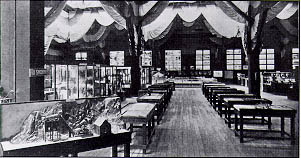
|
| 1934 | The BPR exhibit at the Century of Progress Exposition in Chicago, IL, includes changing maps and dioramas showing the progress of highway development in the United States from 1792 to the present. The history begins in 1792 with authorization of the Lancaster Turnpike in Pennsylvania, the best highway of its day, and ends, according to The Highway Magazine, with "an ultra- modern four-lane highway of 1933, with its bus stations at a grade-separated highway intersection, and its bordering sidewalks and landscape treatment. This type of thoroughfare [is] the supreme development of the cooperative work of engineers of the State highway departments and the Bureau of Public Roads." |
| 1973 | Secretary of Transportation Claude Brinegar administers the oath of office to Administrator Norbert "Nobby" Tiemann. |
June 2
| 1920 | Chief Thomas MacDonald, National Park Service founder Stephen Mather, and other officials in Washington, DC, wish pathfinder and temporary BPR Special Agent A. L. Westgard success on his trip to identify the best route for the National Park-to-Park Highway loop of western National Parks.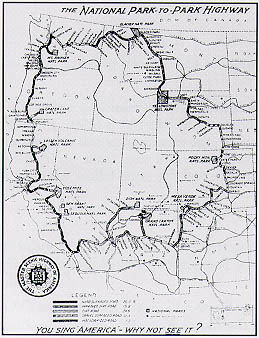
|
| 1958 | Today is moving day for Washington Headquarters employees who report for duty in their new offices in the Matomic Building (1717 H Street, NW)--521 employees from offices in the GSA Building, 26 from the United Steel Workers Building, and 3 from the National Association of Plumbing Contractors' Building. They join employees from the Defense Plans and Operations Division, who moved on May 12, and the Law Library (May 24). The move will be completed in 1960, with BPR occupying floors 5 through 10. ("Matomic" comes from the building's owner, Jerry Maiatico, and the Atomic Energy Commission, the first tenant.) |
| 1979 | FHWA announces that all future roadbuilding contracts will contain provisions to ensure effective control of water pollution from highway construction sites. "In the past," Administrator Frank Turner says, "these pollution controls were voluntary . . . . Henceforth, they will be spelled out in the contracts with provisions made for separate payment for the control work performed." |
| 1988 | Secretary of Transportation James Burnley and Administrator Robert Farris are among the guests participating in the opening of the 10-mile I-93 Franconia Notch Parkway in New Hampshire. Controversy, particularly related to the rock landmark known as the "Old Man of the Mountain," resulted in a compromise parkway design. The finished highway includes sections of Interstate highway, a four-lane parkway, a three-lane parkway, and a two-lane parkway. |
June 3
| 1922 | BPR and the Nevada State Highway Department formally accept as completed an improved highway across the notorious "Fallon Sink" in Churchill County, a sand and alkali flat that had bedeviled motorists for years. The road, with a 20-foot wide crushed-rock and gravel surface and 18-foot turnouts every 2,000 feet, opens on June 4. |
| 1993 | Secretary of Transportation Federico Pea (the first Hispanic-American to hold the post) administers the oath of office to Rodney E. Slater as Federal Highway Administrator, the first African-American to hold the position. A swearing in ceremony takes place on June 16, with Slater's family in attendance.
"The challenge before us is to pursue advances in technology which will yield a seamless intermodal transportation network with the Nation's highways serving as the backbone of that system." |
June 4
| 1923 | Chief Thomas MacDonald joins President Warren Harding during the dedication of the permanent Zero Milestone ("POINT FOR THE MEASUREMENT OF DISTANCES FROM WASHINGTON ON HIGHWAYS OF THE UNITED STATES") on the Ellipse south of the White House. A marching song, composed for the occasion ("Hail! Hail! The Caravan!"), is performed by the U.S. Army Band.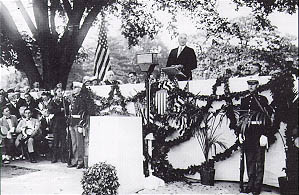
"As we shall extend and improve our highways and more and more adapt them to the methods of transportation, we shall strengthen year by year the ties of mutual interest and interdependence which united all our sections." |
| 1982 | Secretary of Transportation Drew Lewis announces appointments to the National Motor Carrier Advisory Committee. He says the committee, which will develop reports and recommendations for FHWA, "represents a cross section of viewpoints concerning motor carrier policies." Thomas P. Holian of FHWA's Office of Chief Counsel is designated the committee's Executive Director. |
June 5
| 1912 | W. Rees Jeffreys of the British Road Board attends an ARBA dinner at the Hotel Astor in New York City. After Jeffreys compares English and United States roads, Director Logan Page speaks of his embarrassment that the United States is not a member of PIARC. He also mentions that American automobiles are now built on European lines, and he hopes that American roads would also be made to resemble those of Europe. |
| 1984 | FHWA issues a final rule designating a National Network for commercial vehicle use, as required by the Surface Transportation Assistance Act of 1982. Administrator Ray Barnhart says the National Network, which includes the Interstate System and approximately 139,000 miles of non-Interstate primary routes, "provides a safe and efficient highway environment for the commercial transportation of materials and manufactured products between the nation's market centers." |
June 6
| 1932 | President Herbert Hoover signs the Revenue Act of 1932, authorizing the first Federal gas tax, 1 cent a gallon. The revenue is paid into the general fund for deficit reduction.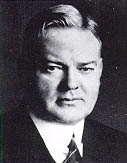
|
| 1972 | Secretary of Transportation John Volpe addresses the Western Association of State Highway Officials in Salt Lake City, UT. He states that when asked what our national highway policy is, "My answer is brief: we don't have one. What we have is a National Transportation Policy." He adds that given the recent emphasis on environmental and social issues, "I've had highway contractors, and even a State highway director or two, come up to me and say, 'Are you the same John Volpe who used to be President of the AGC?' or 'Are you the same fellow who was in on the start of the Interstate System back in '56?'" |
June 7
| 1951 | In response to the Korean War, the authority to approve construction involving more than 25 tons of steel is delegated from the National Production Authority to the Commerce Secretary, who immediately redelegates it to the BPR Commissioner. |
| 1968 | Secretary of Transportation Alan Boyd announces the creation of an Environmental Development Division in FHWA to guarantee full consideration of environmental factors in the location, design, and construction of freeways. The Division, headed by former Connecticut Division Engineer Harold C. King, will be staffed with urban planners, architects, landscape architects, sociologists, economists, and highway engineers. |
June 8
| 1918 | The first meeting of the U.S. Highways Council, with Director Logan Page as chairman and BPR's J. E. Pennybacker, Jr., as secretary, takes place in Page's office. The U.S. Army, the War Production Board, the Fuel and Railroad Administrations, and the Capital Issues Committee participate. The council coordinates the government's highway activities, including shipment of road materials by railroad cars. Between this date and the end of the war, on November 11, 1918, 25 meetings of the council are held. On November 13, 1918, the council holds a special meeting to announce that no further applications will be needed for highway projects. "Procedures in securing materials for transportation should follow normal practices." |
| 1988 | Secretary of Transportation Jim Burnley administers the oath of office to Administrator Robert E. Farris, who had served as Deputy Administrator since August 1986.
"We at the FHWA have a clear sense of purpose. We know what we are here to accomplish, and we have a commitment to building the safest, best designed and best constructed highway system the world has ever known." |
June 9
| 1967 | Frank Turner, Director of FHWA's BPR, says the last slab of concrete has been poured on a 63-mile stretch of the Inter-American Highway in Panama, bypassing a primitive, dangerous road between Guabala and Santiago, cutting the 3-hour driving time in half. The project, which included the first use of slip-form paving in Latin America, ends the United States' 30-year participation in Panama highway construction.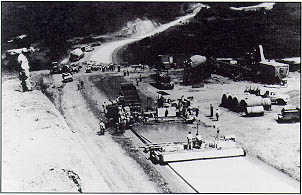
|
| 1976 | FHWA announces Demonstration Project No. 39, "Recycling Asphalt Pavement." The announcement notes that the energy crisis following an oil embargo (see October 17, 1973) had created new concerns about our energy supply. "This crisis, coupled with rising costs, material scarcities, and the diminishing proximity of quality aggregates, has seriously affected the highway industry." Demonstration Project No. 47, "Recycling Portland Cement Concrete Pavements," will be announced on May 5, 1978. |
| 1998 | In a ceremony in the Old Executive Office Building, President Bill Clinton signs the Transportation Equity Act for the 21st Century (TEA-21), which reauthorizes Federal-aid highway, transit, and safety programs through FY 2003. He says that TEA-21 "will strengthen America by modernizing and building roads, bridges, transit systems, and railways to link our people and our country together and to permit a freer flow of goods." |
| 1925 | C. H. Purcell, BPR's District 3 Engineer in Portland, OR, opens bids for several projects in the Pacific Northwest, the most important of which is the Transmountain Road (Going-to-the-Sun Road) in Glacier National Park, MT. The low bid of $869,145 for 12.4 miles of construction is submitted by Williams and Douglas of Tacoma, WA. The idea for the highway came from NPS founder and Director Stephen T. Mather. (See July 15, 1933.)
"It is doubtful if any other road in America can in the same distance unfold to the traveler such a grand array of beautiful forests, dashing mountain torrents, wonderful gorges and valleys, towering cirques, a hundred waterfalls, glaciers, and a vista of bold needle-peaked mountains and serrated escarpments, as will [the Going-to-the-Sun Road]." |
| 1947 | PRA holds the first meeting of the Board of Urban Consultants. The 2-day meeting covers questions related to the 1944 Federal-Aid Highway Act, the status of urban projects, intergovernmental cooperation, and urban planning problems. |
| 1949 | BPR issues instructions and forms for the Board of County Engineer Consultants to study local highway administration as part of a larger BPR study, requested May 27 by the Senate Committee on Public Works, on the economic, engineering, financial, and administrative phases of the local rural road problem. The report is submitted in January 1950. |
June 11
| 1910 | OPR moves to a larger building at 14th and B Streets, SW., Washington, DC, between B and C Streets. The building, formerly occupied by the Agriculture Department's Bureau of Chemistry, has been thoroughly remodeled to suit OPR's needs. |
| 1960 | U.S. Senator Harry F. Byrd of Virginia opens the Blue Ridge Parkway Bridge over the James River. The ceremony allows the use of 114 continuous miles of parkway from Shenandoah National Park to U.S. 460 outside Roanoke, VA. F. W. Cron, Regional Engineer for Region 15, attends the ribbon-cutting, noting that the excellent condition of the highway is a tribute to the NPS's maintenance activities. |
June 12
| 1924 | Governor Len Small of Illinois breakfasts with 38 representatives of Latin American countries. The visitors began their tour in Washington, DC, on June 2, where they met with the sponsoring Highway Education Board and President Calvin Coolidge ("We desire to profit by your experience and I hope that you may profit by ours"). On June 3, BPR officials conducted the visitors on a tour of the experimental farm in Arlington, VA. That evening, they embarked on a tour of the States arranged by Chief Thomas MacDonald and S. T. Henry, Director of the Pan-American Highway Commission. In Illinois, the visitors see Abraham Lincoln's tomb in Springfield and inspect the Bates Test road, on which the Illinois Division of Highways and BPR conducted pavement tests (1920-1923).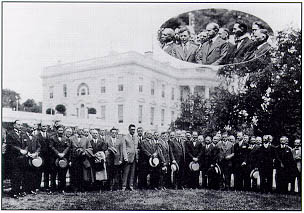
|
| 1979 | At the Four Seasons Motor Hotel in Albuquerque, NM, during the 58th Annual Meeting of the Western Association of State Highway and Transportation Officials, FHWA demonstrates a new low-cost, durable pavement marking material, known as epoxy thermoplastic, developed as an alternative to conventional traffic paints. Associate Administrator for Research and Development Gerald Love says it is "non-polluting, extremely durable, and available as a generic formulation." |
| 1995 | In a case growing out of a Federal Lands highway project in Colorado, the U.S. Supreme Court rules that Federal affirmative action programs are constitutional only if they serve a compelling governmental interest and must be narrowly tailored to address identifiable past discrimination (Adarand Constructors vs Pea). |
June 13
| 1962 | Bids are opened in Helena, MT, for a contract to construct a 32.5-mile section of the Lewis and Clark Highway from a junction with U.S. 93 near Missoula to the Idaho line at Lolo Pass. The road joins with a 38.7-mile section scheduled to be opened on August 19 (Governors Tim Babcock of Montana and Robert E. Smylie of Idaho will saw a log blocking the road in a ceremony at Packers Meadow). According to BPR's Ed Cowan, work on the 32.5-mile section includes grading along the existing road, base surfacing, and raising three bridges within 200 days after the contract is awarded. "Particular attention is to be given to the contractors' operations in both States to permit public travel through the construction and assure that inconvenience will be held to a minimum." |
| 1975 | On behalf of Administrator Norbert Tiemann, Kentucky Division Engineer Robert Johnson presents the first FHWA Public Service Award to John H. Miller, Director of the Metro Louisville Carpool project. |
June 14
| 1911 | OPR's Charles H. Moorefield addresses the annual convention of the North Carolina Good Roads Association on standardizing and systematizing the methods of sand-clay construction so adequate specifications may be prepared. |
| 1944 | Referring to the June 2 introduction of a bill in the House of Representatives that would create a "National System of Interstate Highways," Herbert Fairbank, PRA's Deputy Commissioner for Research, tells the American Planning and Civic Association that the bill "lays the foundation for a long-time Federal-aid program that . . . is new in time and new in form, and it is right in emphasis." Asking, "Dare we fail to modernize our highways and streets?" he responds that, "Years ago, Thomas H. MacDonald gave succinct expression to the answer, when he said that we pay for modern highway improvements whether we have them or not, and we pay less if we have them than if we have not." Fairbank predicts that the new Interstate program will "give the first positive impetus toward the accomplishment of plans for the gradual remodeling of the existing amorphous city structure into a structure of neighborhood and functional cells, logically and naturally arranged."
"To those who doubt on grounds of financial feasibility whether we can afford the modernization of our highway system . . . who say in effect: `Yes, this all sounds very attractive; we recognize the need, but can we accomplish the ambitious ends proposed?' It might be answered that a better question would be: 'Dare we fail?'" |
June 15
| 1964 | In New Mexico, Administrator Rex Whitton meets with Governor Jack Campbell and representatives of U.S. 66 communities fighting construction of an I-40 bypass. Whitton objects to any arrangement that would misroute motorists into the towns. "We want the interstate to be the main route; its got to look like the main route all the time." |
June 16
| 1933 | President Franklin D. Roosevelt signs the National Industrial Recovery Act, providing $400 million for road projects without a matching requirement. For the first time, funds can be used on urban extensions of the Federal-aid system or on "secondary and feeder roads" off system. |
| 1940 | Ceremonies mark the opening of the 13.6-mile East Side Highway just inside the eastern boundary of Mount Rainer National Park, WA. BPR administered 11 contracts over 9 years, with a final cost of $1,381,788. To everyone's surprise, over 5,000 people travel over the road the first day. Continued heavy use of the highway during June overtaxes park campgrounds and other facilities in the southeastern section of the park. |
June 17
| 1980 | Groundbreaking ceremonies take place for the I-95 Fort McHenry Tunnel in Baltimore, MD. Initial plans for a bridge over the Patapsco River were abandoned because of local opposition. The completed $750 million tunnel is dedicated November 23, 1985--on time and $100 million under budget--with Executive Director Lester Lamm representing FHWA during the dedication. The tunnel is the largest underwater highway tunnel and the widest vehicular tunnel ever built by the immersed tube method.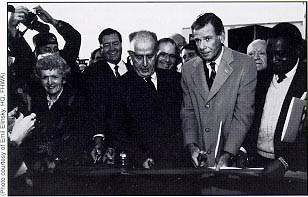
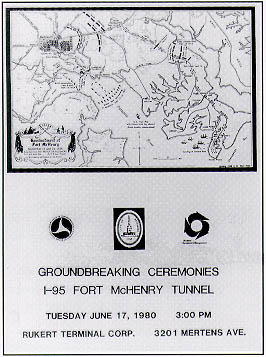
|
| 1987 | Administrator Ray Barnhart urges Congress to schedule hearings on diesel tax evasion. Citing a study by the Internal Revenue Service and the National Association of Tax Administrators, he estimates that hundreds of millions of dollars are lost each year, mainly due to large-scale evasion. |
June 18
| 1934 | The Hayden-Cartwright Act authorizes $200 million for highway projects, with a minimum of 25 percent to be expended on secondary and feeder roads. The act converts matching loans under previous acts to grants; removes limits on construction within municipalities and Federal payment per mile of road; resumes matching requirements abandoned after the Emergency Construction Act of December 20, 1930; applies a penalty to States that divert motor vehicle tax revenue to nonhighway projects; and allows earmarking of up to 1.5 percent of Federal-aid systems funds for surveys, plans, and engineering investigations, the initial legislative authorization for the planning process. Planning funds are soon used for statewide planning surveys that provide the statistical basis for the Interstate System. The President says, "As long as the roads of the Nation are used by more than 24,000,000 automobiles and trucks, construction and improvement of roads will be of major importance." The gold pens the President uses to sign the Act are provided by AASHO. |
June 19
| 1902 | Near Saginaw, MI, work begins on the longest object lesson road to date--nearly 2 miles. After a big meeting in the city, a grand procession, headed by Governor Aaron T. Bliss, the Mayor, and his police force, march about 2 mile out of town to the site. The Governor breaks ground for the work. According to Dodge, "Governor Bliss, therefore, has the credit of being the first Governor to put his hands to the plow in this new and great work of road building by cooperation." |
| 1922 | President Warren Harding signs the Post Office Appropriations Act for FY 1923. Instead of appropriating Federal-aid funds, it "authorized [sums] to be appropriated," the start of contract authority, which allows the States to obligate authorized funds before legislation is passed to provide liquidating cash to pay the amounts claimed. With contract authority, which has continued to the present, States can develop multi-year Federal-aid programs with assurance of the continuity of the program. |
June 20
| 1936 | Public Law 74-848, signed by President Franklin Roosevelt today, officially names the "Blue Ridge Parkway." Other names considered include Skyline Drive, Skyland Drive, Park-to-Park Highway, Scenic Parkway, Shenandoah National Park, Great Smoky Mountains National Park Parkway, the Appalachian National Parkway, the Southern Appalachian Parkway, and The Ickes Highway (after Secretary of the Interior Harold Ickes). Secretary Ickes had recommended the chosen name in a press release on February 18 after receiving an endorsement from the Division of Geographic Names, which favored the name "because the parkway lies upon the Blue Ridge throughout most of the length of both the parkway and the ridge. It is, geographically, a most appropriate name."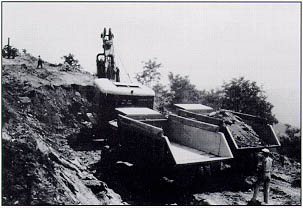
|
June 21
| 1991 | President George Bush addresses AASHTO in the White House's Rose Garden on the surface transportation legislation pending in the Congress (ISTEA). "No transportation partnership," he says, "has endured so long or accomplished as much as the one between the federal government and AASHTO." He also refers to the challenge he issued to Congress during his State of the Union Address to enact the transportation bill within 100 days. The Senate had acted, but not the House. "A challenge of 100 days became an occasion for 100 different delays and 101 excuses for inaction."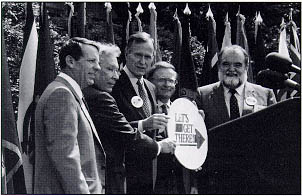
|
June 22
| 1926 | Today is the final day for submitting applications to the U.S. Civil Service Commission for the open competitive examinations for BPR positions: Chief engineering inspector-superintendent ($2,400) and senior engineering inspector-foreman ($1,860). As vacancies occur at higher levels, top pay for the former is $3,000 and for the latter, $2,400. |
| 1929 | At the dedication of the Hiouchi (Blue Water) Bridge on the Redwood Highway near the California/Oregon border, BPR's Dr. L. I. Hewes says, "Sometimes I wonder whether we are aiding the states or whether the states are aiding the United States when we provide Federal aid for roads, for the entire country benefits through good highways." |
June 23
| 1905 | At the Fifth Annual National Good Roads Convention in Portland, OR, Special Agent James W. Abbott of the OPRI speaks on "Transcontinental Highways," endorsing construction of "one or more good through wagon roads from the Atlantic to San Francisco, and to the Northwest." |
| 1964 | Alice Roosevelt Longworth, daughter of President Theodore Roosevelt, cuts the ribbon opening the Theodore Roosevelt Bridge carrying I-66 and U.S. 50 across the Potomac River between Washington, DC, and Virginia. BPR is represented by Administrator Rex Whitton, Acting Deputy Administrator Lowell Bridwell, Chief Engineer Frank Turner, and August Schofer, Charles Hall, and John Sullivan. On April 10, 1992, The Washington Post comments, "Much maligned for its aesthetic deficiencies (though isn't this quibbling, with the Kennedy Center so close by?), this bridge is nonetheless a driver's godsend." |
June 24
| 1909 | In New York, during the annual meeting of the Society for the Promotion of Engineering Education, Director Logan Page makes an earnest plea for the teaching of highway engineering in the engineering schools. |
| 1938 | The 3-day celebration for the opening of South Dakota's first trans-State paved highway ends at Chamberlain, SD. On June 22, Governor Leslie Jensen said, "U.S. Highway No. 16 could be likened to the goose laying the golden egg because completion of hard surfacing will bring a vast increase in traffic, increase in revenue, and wonderful advertising to the State." S. L. Taylor represents BPR during the ceremonies. |
| 1941 | The initial meeting of the National Interregional Highway Committee, appointed by President Franklin Roosevelt, convenes at PRA headquarters (the Federal Works Building) to begin identifying a limited system of national highways designed to provide a basis for improved interregional transportation. Commissioner Thomas MacDonald is Chairman and Herbert Fairbank is secretary. |
| 1964 | BPR's highway research facility in McLean, VA, is named the Herbert S. Fairbank Research Station. A plaque is unveiled at 2:30 by Mrs. Francis Fairbank, wife of his cousin, when his sister, Miss Grace C. Fairbank of Baltimore, MD, is unable to attend due to illness. A tribute says, "His monument, still being built, is an efficient highway system, planned for the future and soundly financed."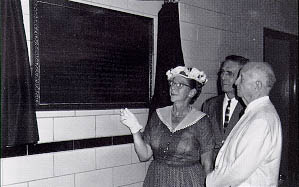
"A gifted writer; a man of brilliance, depth and vision; of warmth, wit, and wisdom; of dedication and integrity; an exacting but inspired leader." |
| 1977 | FHWA drops the proposal to change road signs to the metric system. Following publication of an advance notice of proposed rulemaking in April inviting public comment, FHWA received more than 5,000 comments and, says Administrator William Cox, "about 98 percent of them were negative. There simply was too much opposition to the proposal from the general public." |
June 25
| 1917 | BPR and the Forest Service sign a cooperative agreement for construction of a road across Monarch Pass in Colorado (later part of U.S. 50). W. M. Jeffrey of the BPR ran the location survey in 1917, but work was delayed by World War I (Jeffrey served in France, performing civil engineering and road building duties). Groundbreaking takes place on July 10, 1919, and the completed road is dedicated on September 19, 1921. Groundbreaking takes place on July 10, 1919, and the completed road is dedicated on September 19, 1921. An article in Colorado Highways comments that Jeffrey's feelings during the ceremony "must have been much the same as those of a proud parent who attends the graduation of a favorite child . . . . From the speakers' stand where he stood while he spoke, he could see some of the tools with which he and his men had been working just a few days before. Like old friends were these tools; they seemed to greet him from where they lay in the tall mountain grass, and there, too, was the highway. Just beyond a little copse of aspen it curved and wound its way through the timber and up over the pass." Assistant District Engineer A. E. Palen of BPR commented that for scenery, the road "out switzes Switzerland."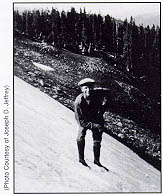
Bureau of Public Roads Engineer |
| 1952 | President Harry Truman signs the Federal-Aid Highway Act, which authorizes the first funding, $25 million, specifically for the Interstate System. |
| 1990 | Deputy Secretary Elaine Chao helps launch the Pathfinder IVHS pilot project in Los Angeles, a cooperative effort by FHWA, the California DOT, and General Motors. |
June 26
| 1956 | Congress completes work on the landmark Federal-Aid Highway Act of 1956 when the House approves the bill by voice vote and the Senate completes congressional action on an 89 to 1 roll call vote. Senator Russell Long of Louisiana is the lone dissenter, saying he believes present taxes are sufficient to finance the program. The bill's chief sponsors, Senator Albert Gore, Sr. (TN) and Representative George H. Fallon (MD), in a joint statement, say the bill will set in motion "the greatest governmental construction program in the history of the world." Fallon adds, "The American people will ride safely upon many thousands of miles of broad, straight, trouble-free roads, four to eight lanes wide, criss-crossing America from coast to coast and border to border, built to the very highest standards that our highway engineers can devise."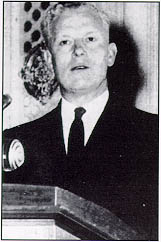
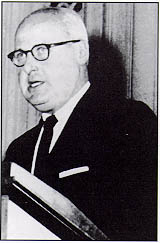
|
||
| 1962 | In Delmar, NY, Region 1 holds a seminar for 12 members of BPR's Executive Reserve--officials from contractors' associations, consulting engineering firms, universities, and retired highway officials who will fill executive posts in the Agency if present top officials are killed or incapacitated in a nuclear attack. Similar seminars will be held in each of BPR's regions, covering all 88 reservists. |
June 27
| 1958 | BPR's Montana Division begins a move to Helena after being in Missoula since April 1918. |
| 1967 | In West Yellowstone, MT, Administrator Lowell Bridwell addresses the Western Governors' Conference on uniform standards for highway safety. He says the Highway Safety Act of 1966 "represented the intention of Congress that the Federal Government support, stimulate, and help the States toward achieving the nationally mandated goal of much greater safety on America's highway network . . . . So we see the future of our standards, and the State programs initiated or improved under them, as a future of close cooperation between and among the Federal and State governments in this area of critical national need." |
June 28
| 1957 | The International Bank for Reconstruction and Development signs an agreement with the Imperial Ethiopian Government for a $15 million highway loan for several purposes, including construction under BPR supervision of 510 miles of roads to open up a potentially rich coffee-producing area. |
| 1969 | Ralph Bartelsmeyer, Director of Public Roads, represents FHWA at the opening of the Verrazano-Narrows Bridge's lower deck, which had been built the same time as the upper deck (opened November 21, 1964) but kept closed until needed--which turned out to be 11 years sooner than planned. Robert Moses, whose Triborough Bridge and Tunnel Authority built the bridge, tells the assemblage, "The ex-post-facto boys of course know just how it should have been done [but give] practical folks their due. Who shall challenge their assertion that man cannot live by ecology and esthetics alone?" |
| 1956 | President Dwight D. Eisenhower, on his last day at Walter Reed Army Hospital following surgery on June 9 for ileitis, signs the Federal-Aid Highway Act of 1956, ushering in the Interstate era. Title I increases the Interstate System to 41,000 miles (from 40,000 miles authorized by the Federal-Aid Highway Act of 1944) and authorizes $25 billion over the period 1957-1969 as the Federal share (90 percent) of the cost of construction. Title II, the Highway Revenue Act of 1956, establishes the Highway Trust Fund and provides that the highway program must operate on a pay-as-you-go basis. Secretary of Commerce Sinclair Weeks tells reporters $1.125 billion would be allocated to the States immediately for "the greatest public works program in the history of the world." The President, he says, "was highly pleased." |
| 1961 | President John F. Kennedy signs the Federal-Aid Highway Act, which increases Interstate authorizations. It revises the existing schedule of highway-user excise taxes and makes permanent the temporary gas tax of 4 cents per gallon approved by the Federal-Aid Highway Act of 1959. These changes provide the sound financial footing needed to complete the Interstate System.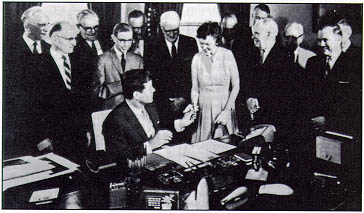
|
| 1977 | The FHWA Regulation Reduction Red Tape Task Force presents its study and recommendations to Administrator William Cox, Deputy Administrator Karl Bowers, and Executive Director Lester Lamm. |
June 30
| 1924 | For the opening of the Mount Hood Loop in Oregon, BPR officials join a caravan of automobiles carrying Forest Service, State and county officials, prominent citizens, and the press. They leave Portland, OR, drive to Government Camp, around the mountain to Hood River, and then back to Portland over the Columbia Highway, thus making the first complete circuit (173 miles) of Mt. Hood by way of the Loop Highway--in 8 hours. BPR supervised construction of the 37-mile section through Mt. Hood National Forest.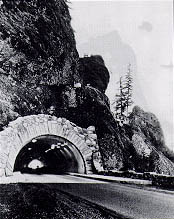
|
| 1933 | For the first time since 1916, the fiscal year ends without definite provision by Congress for continuation of the Federal-aid highway program. However, the National Industrial Recovery Act, approved June 16, provided $400 million for Federal-aid roads and $50 million for forest, park, public lands, and Indian reservation roads. (The Federal-aid program would be reestablished, June 18, 1934, by the Hayden-Cartwright Act for FYs 1936 and 1937). |
| 1961 | Secretary of Commerce Luther Hodges inaugurates operation of the National Driver Register Service in BPR's computer room to maintain records of motor vehicle operators whose license has been revoked. (On June 13, 1967, Administrator Lowell Bridwell announced that the register had made 31,921,825 searches, resulting in 182,679 identifications warranting further investigation.) |
| 1972 | Frank Turner retires as Federal Highway Administrator, ending a BPR/PRA/FHWA career that began immediately after his graduation from Texas A&M University in 1929.
"While many organizations both in and out of Government are impersonal machines, I've always thought of [the FHWA family] as individuals who were dedicated to doing a piece of the public business more as a service to your friends and neighbors than merely a source of employment." |
| 1993 | A Federal Grand Jury in New York indicts eight individuals for allegedly evading $85 million in Federal tax on 946 million gallons of gasoline between 1983 and 1988. This is the largest fuel tax evasion case ever brought by the Department of Justice and brings the total evasion alleged in various indictments over the past 6 months in New Jersey, New York, and Pennsylvania to almost $200 million. FHWA's fuel tax evasion project played a significant role in assisting the Internal Revenue Service and State revenue agencies. |
| 2010 | George Austin Hay, a multimedia specialist in FHWA's Publishing and Visual Communications Team, retires at the age of 94 after 55 years of Federal service, including 37 with FHWA. In his final days at work, Hay is congratulated by Secretary Ray LaHood, Deputy Secretary John Porcari, and Administrator Victor Mendez. On July 2, The Washington Post covers the retirement - in part because of Hay's sideline as an actor who appeared as an extra in such films as North by Northwest (1959), Being There (1979), Her Alibi (1989), The Contender (2000), and Ladder 49 (2004). |
Also in June
| 1897 | 1897 The first object lesson road is built by ORI at the entrance to the New Jersey Agricultural College and Experiment Station at New Brunswick, NJ. The work, conducted by General E. G. Harrison of Asbury Park, NJ, involves placing 6 inches of trap rock macadam, 8 feet wide, on a 660-foot section of the main road from the town to the college farm. ORI's cost consisted only of Harrison's salary and travel expenses, the expense of transporting loaned equipment, and part of the wages of the equipment operators. Otherwise, the road cost $321, which was paid by the college.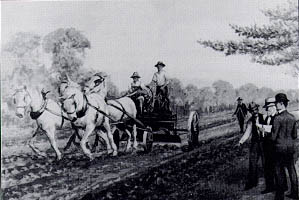
|
| 1923 | This month's issue of The Highway Magazine contains an article on "Doctoring the Sick Highways," based on an "authentic interview" with BPR's Chief Testing Engineer, Earl B. Smith. Smith tells the reporter, "It is known that there are four important factors to be considered in road design, namely: impact; pressure or weight of the passing load; horizontal shear and tractive forces; subgrade and soil conditions . . . . More progress has been made in the study of impact than any of the other factors." |
| 1954 | Volume 1, Issue 1 of The News in Public Roads is issued. According to a note from Commissioner F. V. du Pont, "Our purpose is a serious one--to enable our employees to know our organization better and convince them that it is doing a work of great public benefit." He adds that with employees widely dispersed around the world, "If the publication succeeds in bringing us closer together with a common understanding and purpose, it will be worth the effort in producing it." The initial editor is C. M. Billingsley of the Research Reports Branch. John Zolyak takes over with the August 1957 issue, continues as editor after the newsletter becomes Federal Highway Administration News (May 1967), and remains editor through the August 1979 issue. The newsletter was renamed FHWA News on December 24, 1969. |
| 1964 | The HRB of the National Academy of Sciences releases the first published report of the Nationally Coordinated Highway Research Program ("Highway Structure Protection and Snow and Ice Removal," based on research by Bertram D. Tallamy Associates of Washington, DC). AASHO, with BPR cooperation, sponsors the program, underwrites the research, and identifies areas of greatest research need. |

